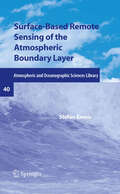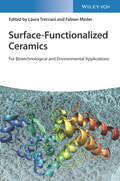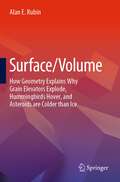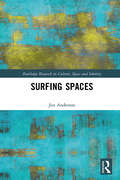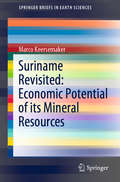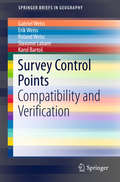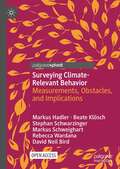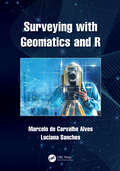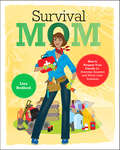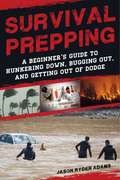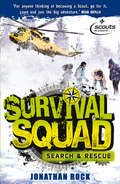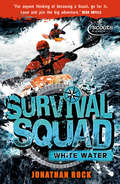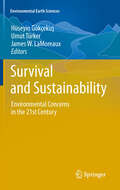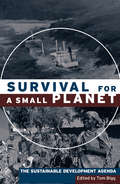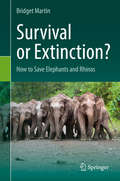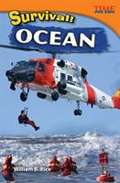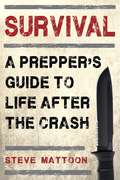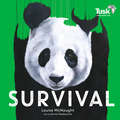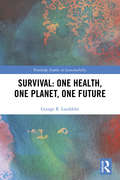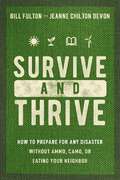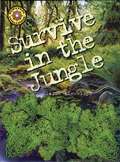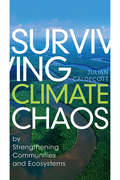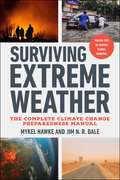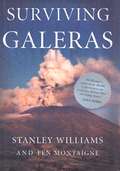- Table View
- List View
Surface-Based Remote Sensing of the Atmospheric Boundary Layer
by Stefan EmeisThe book presents a comprehensive overview of the current state-of-the-art in the atmospheric boundary layer (ABL) research. It focuses on experimental ABL research, while most of the books on ABL discuss it from a theoretical or fluid dynamics point of view. Experimental ABL research has been made so far by surface-based in-situ experimentation (tower measurements up to a few hundred meters, surface energy balance measurements, short aircraft experiments, short experiments with tethered balloons, constant-level balloons, evaluation of radiosonde data). Surface flux measurements are also discussed in the book. Although the surface fluxes are one of the main driving factors for the daily variation of the ABL, an ABL description is only complete if its vertical structure is analyzed and determined. Satellite information is available covering large areas, but it has only limited temporal resolution and lacks sufficient vertical resolution. Therefore, surface-based remote sensing is a large challenge to enlarge the database for ABL studies, as it offers nearly continuous and vertically highly resolved information for specific sites of interest. Considerable progress has been made in the recent years in studying of ground-based remote sensing of the ABL. The book discusses such new subjects as micro-rain radars and the use of ceilometers for ABL profiling, modern small wind lidars for wind energy applications, ABL flux profile measurements, RASS techniques, and mixing-layer height determination.
Surface-Functionalized Ceramics: For Biotechnological and Environmental Applications
by Laura Treccani Fabian MederSurface-Functionalized Ceramics Focused coverage of making and using functional ceramic materials for a wide variety of scientific and technical applications Surface-Functionalized Ceramics provides a comprehensive overview of surface functionalization approaches for ceramic materials, including alumina, zirconia, titania, and silica, and their uses as sensors, chemical, and biological probes, chromatographic supports for (bio)molecule purification and analysis, and adsorbents for toxic substances and pollutants. Overall, the text provides a broad picture of the enormous possibilities offered by surface functionalization and addresses the current challenges regarding surface analysis, characterization, and stability. As a well-rounded resource, the text points out opportunities of surface-functionalized ceramics, their issues such as achieving surface stability and complex analysis, and how to counter them. Edited by two experts in the field of advanced materials surfaces, Surface-Functionalized Ceramics covers topics such as: Processing methods for advanced ceramics, surface modification of ceramic materials, and methods for electrokinetic surface characteristics Surface imaging and chemical surface analysis using atomic force microscopy Surface chemical analysis and ceramic-enhanced analytics Biological and living matter-surface interactions including protein adsorption mechanisms as well as bacteria behavior in terms of biofilm formation and prevention for antibacterial applications Mesoporous silica and organosilica biosensors for water quality and environmental monitoring, plus ceramic-based adsorbents in bioproduct recovery and purification For professionals, researchers, and academics in the fields of materials science, biotechnology, biotechnological industry, environmental sciences, and ceramics industry, Surface-Functionalized Ceramics is a one-stop reference on the subject that provides different approaches to obtain surfaces of ceramic materials that perform desired functions.
Surface/Volume: How Geometry Explains Why Grain Elevators Explode, Hummingbirds Hover, and Asteroids are Colder than Ice
by Alan E. RubinThis book explains that diffusion, osmosis, dissolution, evaporation, and heat loss all preferentially affect small bodies due to their high surface/volume ratios. Because surface area increases as the square of length, but volume (and mass) increase as the cube, large objects have low surface/volume ratios and small objects have high surface/volume ratios. This simple physical constraint governs much of the physical world. It accounts for why the Earth has active volcanoes, but the Moon does not, why the human brain has numerous folds, why deciduous trees lose their leaves every Fall, and why nanoparticles of gold melt at surprisingly low temperatures. It is a phenomenon well known to every scientist, but this book is the first comprehensive treatment of this effect.
Surfing Spaces (Routledge Research in Culture, Space and Identity)
by Jon AndersonThe act of surfing involves highly-skilled humans gliding, sliding, or otherwise riding waves of energy as they pass through water. As this book argues, however, this act of surfing does not exist in isolation. It is defined by the cultures and geographies that synergize with it – by the places, ideas, images, and other representations which at once reflect, create, and commodify this spatial practice. This book innovatively explores the spaces of surf and surf-riding, informed specifically by the perspective of human geography. Based on a range of critical turns within the social sciences, the book explores the locations, relational sensibilities, and transformative nature of surfing spaces, and examines how the spatial practice has been scripted by dominant surfing cultures. The book details how prescriptive (b)orders of access, entitlement, and marginalization have been created, and how, with the advent of new craft, media, and ideals, they are being actively challenged to redefine surfing spaces in the twenty-first century.
Suriname Revisited: Economic Potential of its Mineral Resources (SpringerBriefs in Earth Sciences)
by Marco KeersemakerThis book summarizes the exploration history and provides a framework for assessing the economic potential of the country’s minerals by defining minimal deposit parameters for the various commodities present. Suriname was explored extensively for mineral occurrences in the course of the previous century, indicating the presence of a range of commodities. The country mined and processed bauxite for a century (until 2016), and has an even longer history of small-scale alluvial gold mining; it is currently home to two major gold producers. However, exploration activities have been limited during the past 4 decades as most parts of Suriname’s interior are difficult to access, making geological fieldwork both difficult and expensive. Further, the markets and prices have changed in the interim, which calls for a fresh look at the historic data.
Survey Control Points
by Gabriel Weiss Erik Weiss Roland Weiss Slavomír Labant Karol BartošThis work deals with the issue of geodetic network structures, i. e. methods of verifying the condition of existing geodetic controls in terms of their compatibility and thereby their applicability. The presented work addresses these problems only for geodetic controls on a local scale. This is a common surveying issue in a number of countries, especially where there are concerns about the quality of the structure and homogeneity of national spatial and triangulation networks. There is a need for verification, not only for the use of terrestrial methods of determination of points but also for other surveying technology, since all technology operates with a certain threshold accuracy and using physical marks located on an unstable earth surface as survey control points. Issues of the compatibility of points whose coordinates are defined as functions of time by specific equations with respect to basal positions of points at certain epochs (points in systems ITRS, ETRS and others) are not considered.
Surveying Climate-Relevant Behavior: Measurements, Obstacles, and Implications
by Markus Hadler Beate Klösch Stephan Schwarzinger Markus Schweighart Rebecca Wardana David Neil BirdThis open access book discusses the contribution of sociology and survey research to climate research. The authors address the questions of which behaviors are of climate relevance, who is engaging in these behaviors, in which contexts do these behaviors occur, and which individual perceptions and values are related to them. Utilizing survey research, the book focuses on the measurement of climate-relevant behaviors with population surveys and develops an instrument that allows a valid estimate of an individual’s GHG emissions with a few core items. While the development of these instruments was based on surveys and qualitative interviews conducted in Austria, the instruments were subsequently tested in a set of 31 European countries, revealing the international relevance of such research. The book also concludes with a brief consideration of the effects of the COVID-19 crisis on environmental attitudes, situating the project globally.
Surveying with Geomatics and R
by Marcelo de Carvalho Alves Luciana SanchesSurveying with Geomatics and RThis book explains basic concepts of surveying science and techniques with geomatics using R software and R packages. It engages students in learning about surveying through real field examples and using differing degrees of complexity while exploring surveying problems based on field observations and advanced geospatial technology. It includes a wide range of case studies as hands-on and self-paced tutorials along with detailed computer programming routines that are linked to the theories and applications explained in each chapter. This innovative textbook also teaches how to explore other possibilities of using geomatics in geocomputation, remote sensing, geography and cartography courses focused on surveying tasks.Features include: Provides modern surveying practices with free software algorithm and R toolset for active learning Includes case studies from different geographical areas using arbitrary and international cartographic reference systems Enables and demonstrates the integration of traditional geomatics with modern geospatial big data technologies Explains data standards, equipment used, possible analyses and the importance of error evaluation for scientific surveying Discusses different scales of landscapes and brings together the experiences of leading experts in the field
Survival Mom: How to Prepare Your Family for Everyday Disasters and Worst-Case Scenarios
by Lisa BedfordFrom the creator of TheSurvivalMom.com comes this first-of-its-kind guidebook for all the “prepper” moms keen to increase their family's level of preparedness for emergencies and crises of all shapes and sizes. Publisher’s Weekly calls Lisa Bedford’s Survival Mom an “impressively comprehensive manual,” saying, “suburban mom Bedford helps readers learn about, prepare for, and respond to all manner of disasters. . . . From 'Instant Survival Tip' sidebars to a list of 'Lessons from the Great Depression'. . . Bedford's matter-of-fact yet supportive tone will keep the willies at bay.”
Survival Prepping: A Guide to Hunkering Down, Bugging Out, and Getting Out of Dodge
by Jason Ryder AdamsFood, Water, First Aid, and Self-Defense Tips for Surviving Natural Disasters, Extreme Weather, Pandemics, Biological Threats, Terrorist Attacks, and Riots It could be a fire, flood, hurricane, tornado, or hailstorm. Financial system collapse or bioterrorism. Governmental shutdown or societal breakdown. The world is full of possible threats, and they seem to be coming at us from all sides these days. Jason Ryder Adams covers everything you need to know prepare your home, keep your family safe, and get ready to leave if the worst happens. You’ll learn how to: Prep with children and pets (and do test runs ahead of time)Plan for staying put, sealing yourself in, and leaving depending on the threatChoose and protect a safe location and develop an escape routeDefend your family with self-defense training and firearmsPut together a 72-hour emergency kit, bug-out bag, and first aid kit So don’t panic—prepare! Prepping today is for everyone. Survival Prepping is written for ordinary folks who want to get started on preparing for the worst. Adams shares bug-out plans for every scenario, safety tips, and invaluable checklists for acquiring the right supplies for emergency situations. Survival Prepping will help you ensure your family survives—and hopefully thrives—should a disaster strike.
Survival Squad: Book 2 (Survival Squad #2)
by Jonathan RockThere's a reason they're known as the Survival Squad...It's winter and the snow is falling thick and fast. The Tiger Patrol are learning to ski, building snow shelters, and igloos. They're even working with the local search and rescue team. Then they're caught in a snow blizzard and a young girl is missing in the snow...Time is running out for the Survival Squad.
Survival Squad: Book 4
by Jonathan RockThere's a reason they're known as the Survival Squad...A white water rafting expedition for the Tiger Patrol takes a turn for the worse when the water level rises. It's a matter of life or death, and they have only their training and skill to rely on.
Survival and Sustainability
by James W. Lamoreaux Umut Türker Hüseyin GökçekusThe International Conference on Environment: Survival and Sustainability, held at the Near East University, Nicosia, Northern Cyprus 19-24 February 2007, dealt with environmental threats and proposed solutions at all scales. The 21 themes addressed by the conference fell into four broad categories; Threats to Survival and Sustainability; Technological Advances towards Survival and Sustainability; Activities and Tools for Social Change; Defining Goals for Sustainable Societies. Activities and tools that move the society towards greater sustainability were emphasized at the conference. These included environmental law and ethics, environmental knowledge, technology and information systems, media, environmental awareness, education and lifelong learning, the use of literature for environmental awareness, the green factor in politics, international relations and environmental organizations. The breadth of the issues addressed at the conference made clear the need for greatly increased interdisciplinary and international collaboration the survival and sustainability concept. The exchanges at the conference represent a step in this direction.
Survival for a Small Planet: The Sustainable Development Agenda
by Tom BiggFew scientific developments have given rise to as much controversy as biotechnology. Numerous groups are united in their opposition, expressing concern over environmental and health risks, impacts on rural livelihoods, the economic dominance of multinational companies and the ethical implications of crossing species boundaries. Among the supporters of the technology are those that believe in its potential to enhance food security, further economic development, increase productivity and reduce environmental pressures. As a result, countries - and sectors within countries - find themselves at odds with each other while potential opportunities for development offered by the use of biotechnology are seized or missed, and related risks go unmanaged. This book, a unique interdisciplinary collection of perspectives from the developing world, examines the ongoing debate. Writing for the International Centre for Trade and Sustainable Development, leading experts address issues such as diffusion of technology, intellectual property rights, the Cartagena Protocol, impacts of international trade, capacity building and biotechnology research and regulation. With the most recent and relevant examples from around the world, Trading in Genes offers the reader a single-volume overview of the connections between biotechnology, trade and sustainability that is both wide-ranging and thorough.
Survival or Extinction?: How to Save Elephants and Rhinos
by Bridget MartinWritten with passion for anyone interested in seeing an end to the illegal trade in elephant ivory and rhino horn, this book shows how, by working together, people all over the world who care about these animals are gradually bringing about change for the better. It takes an overview of how the current situation came to pass by exploring poaching and its devastating consequences and the pivotal role of organized crime. The discussion of how matters are starting to improve covers the investigation and monitoring of ivory markets, sustainable uses and the key role of local communities.Enforcement of the law is vital in this story. Enter the enforcers, the technology they use to defeat the poachers and the evidence they require to prosecute offenders. Cases, some deeply shocking, are included, as well as a number of fascinating case studies, while the exploits of organized crime gangs make lively, as well as disturbing reading. Throughout the message is clear. We can and must save these animals from extinction.
Survival!: Ocean (Time For Kids Informational Text Series)
by William B. RiceWhat do you do if you find yourself stranded at sea? This useful nonfiction book gives readers the information they need in order to survive at sea. With essential tips and instructions, helpful diagrams and images, a bibliography, and a list of other useful websites, readers will learn everything they need in order to survive--from the dangers of hypothermia, what to do if there's only saltwater available, and other useful survival skills.
Survival: A Prepper?s Guide to Life after the Crash
by Steve MattoonDefend what’s yours when catastrophe strikes with expert tips that go beyond food and water storage.Should a national disaster occur, how will you respond? What will occur when critical societal services cease to function? As a prepper, you will likely be ready to hole up and live off of your stored supplies, at least for a while. But what do you do during that time? What are your next steps? And how do you defend yourself against others who have not prepared for such a disaster?After the Crash covers all the situations that you may face when the lack of governmental infrastructure leads to social upheaval and chaos. Since most of the population is unprepared for a disaster of any kind, this book gives both the trained and untrained prepper valuable information needed to have any chance of survival in a world where organized government assistance may not be available. Importantly, he details the crucial steps you need to take in addition to doing everything other survival manuals advise. These critical tips go beyond stockpiling food, water, and weapons.Offering battle-proven advice, Steve Mattoon explores what it takes to survive alone versus in groups, each approach presenting its own advantages and challenges. Discover how best to defend yourself, what to use, and how to most effectively use the tools you have at your disposal. Whether you find yourself in a rural area or an urban jungle, Steve Mattoon’s After the Crash will prove an essential addition to any prepper’s bug-out bag.
Survival: Are You Tough Enough? (White Wolves Non Fiction)
by Anna Claybourne Louise McNaughtFrom the rainforest to the savannah to the depths of the ocean, animal life in every continent and habitat has been affected by human activity. Louise McNaught's powerful animal portraits bring to life 20 stunning creatures and their fight for survival. Discover the dangers they face, the action being taken to protect them, and their vital importance on Earth.Be inspired to join the movement to conserve species and find out how you can make a difference.
Survival: One Health, One Planet, One Future (Routledge Studies in Sustainability)
by George R. LueddekePlanet Earth has been here for over 4.5 billion years but in just two human generations we have managed to place our only 'home' at great risk. Many lessons from history have not yet been learned and new lessons may prove equally, if not more, difficult to take on board as we head deeper into the twenty-first century. This book highlights two of our greatest social problems: changing the way we relate to the planet and to one another, and confronting how we use technology (dataism) for the benefit of both humankind and the planet. Covering a wide range of key topics, including environmental degradation, modern life, capitalism, robotics, financing of war (vs peace) and the pressing need to re-orient society towards a sustainable future, the book contends that lifelong learning for sustainability is key to our survival. The author argues that One Health - recognising the fundamental interconnections between people, animals, plants, the environment - needs to inform the UN-2030 Sustainable Development Goals and that working towards the adoption of a new mindset is essential. We need to replace our current view of limitless resources, exploitation, competition and conflict with one that respects the sanctity of life and strives towards well-being for all, shared prosperity and social stability. Clearly written, evidence based and transdisciplinary - and including contributions from the World Bank, InterAction Council, Chatham House, UNESCO, World Economic Forum, the Tripartite One Health collaboration (UN Food and Agriculture Organization, World Organisation for Animal Health and World Health Organization), One Health Commission and more - this book cuts across sociopolitical, economic and environmental lines. It will be of great interest to practitioners, academics, policy-makers, students, nongovernment agencies and the public at large in both developed and developing nations.
Survive and Thrive: How to Prepare for Any Disaster Without Ammo, Camo, or Eating Your Neighbor
by Jeanne Devon Bill FultonGet ready for a refreshing and unique take on preparedness. This essential guide is for regular people who want to handle disaster situations confidently, without digging a network of underground bunkers stockpiled with weaponry.From the really loud wake-up call of the COVID-19 pandemic to the escalating climate crisis, the world is becoming increasingly unpredictable. It&’s time to buckle up—but fear not! Army vet and sustainable organic farmer Bill Fulton and Alaska adventurer and writer Jeanne Chilton Devon will demystify the whole notion of "prepping" and make it accessible and practical for everyone.In this comprehensive handbook, you'll learn essential knowledge like water sourcing and purification, long-term food storage, stocking a disaster pantry, creating a safe home, assembling evacuation bags, and ensuring your family doesn't drive each other crazy in the face of chaos. You'll also unlock cool survival hacks to save the day when the lights are out, the gas is off, the supermarket is closed, and everyone around you is hunkered down like a mountain hermit.Unlike other prepping guides, Survive and Thrive recognizes that what we need is a collaborative, sustainable, and family-friendly approach to preparedness. Say goodbye to doomsday paranoia and learn empowering information to help you live better now and have a solid plan for whatever comes tomorrow. SPOILER: That's how we all make it through the 21st century!With an upbeat attitude, detailed instructions, how-tos, checklists galore, and even historical survival recipes, city dwellers and suburbanites alike will get organized and on the path to sustainability and resilience—whatever may come!
Survive in the Jungle
by Claire LlewellynDo you have what it takes to survive in the jungle? Can you build a shelter, find food that's safe to eat, handle extreme humidity, and treat a poisonous snakebite? Imagine that you are lost in the jungle with only a few useful items--how would you survive until you are rescued? This book explores all aspects of enduring life in the jungle. Read through all 12 exciting challenges and learn how to endure extreme conditions. You can even try some of the ideas at home! When you master these challenges, put your knowledge to the test by taking a quiz to see if you are a true survivor! This entertaining book tests children's ability to survive in the jungle with 12 tasks ranging from building a shelter and finding food and water to how to treat a snakebite and fend off nasty bugs. Each page features color photographs to make this a realistic adventure, as well as a question-and-answer section, important tips, at-home activities, and a set of survival tools to stimulate children's skill and reasoning power and inspire them to trust their judgment. The cover featuring a plastic water bug and snake add to the fun. For 8 to 12-year-olds.
Surviving Climate Chaos: by Strengthening Communities and Ecosystems
by Julian CaldecottSurviving climate chaos needs communities and ecosystems able to cope with near-random impacts. Their strength depends upon their integrity, so preserving and restoring this is essential. Total climate breakdown might be postponed by extreme efforts to conserve carbon and recapture pollutants, but climate chaos everywhere is now inevitable. Adaptation efforts by Paris Agreement countries are converging on community-based and ecosystem-based strategies, and case studies in Bolivia, Nepal and Tanzania confirm that these are the best ways forward. But success depends on local empowerment through forums, ecosystem tenure security and environmental education. When replicated, networked and shielded by governments, they can strengthen societies against climate chaos while achieving sustainable development. These vital messages are highlighted for all those who seek or have already found a role in promoting adaptation: for students, researchers and teachers, government officials and aid professionals, and for everyone who is now living under threat of climate chaos.
Surviving Extreme Weather: The Complete Climate Change Preparedness Manual
by Mykel Hawke Jim N.R. DaleThe only guide you need to prepare for the dangerous effects of climate change. The world has changed, and impacts of global warming means weather events like extreme heat, wildfires, hurricanes, and droughts are now being felt by all of us. We can ignore climate change no longer and must prepare ourselves to survive in new conditions. The key to surviving extreme weather events is to understand them from a practical perspective and then plan and execute tactical responses. In Surviving Extreme Weather, Mykel Hawke, a renowned survivalist and bestselling author of Hawke&’s Special Forces Survival Handbook and Hawke&’s Green Beret Survival Manual, and British meteorologist Jim N. R. Dale, share their expert knowledge and personal experiences while offering valuable insights into the science behind our new weather and how to apply situational awareness, preparedness, and psychology to survive.Surviving Extreme Weather: The Complete Climate Change Preparedness Manual is categorized by elements—fire, water, wind, and earth—events are explained with recommendations anyone can follow to protect themselves and their family, and to minimize the risks of damage to life and property. Included are lists of items every person, home, business, and vehicle should always stock, such as: first aid kits, afflictions, and applications; emerging technologies to help protect against different weather phenomena; structural and landscape precautions and improvements; philosophies to help family, friends, and neighbors get through any environmental ordeal.
Surviving Galeras
by Stanley Williams Fen MontaigneThis true, up-close account of a volcano&’s eruption &“artfully blends science writing and history with pure, heart-pounding action&” (Mark Bowden, bestselling author of Black Hawk Down). In 1993, Stanley Williams, an eminent volcanologist, was standing on top of a Colombian volcano called Galeras when it erupted, killing six of his colleagues instantly. As Williams tried to escape the blast, he was pelted with white-hot projectiles traveling faster than bullets. Within seconds he was cut down, his skull fractured, his right leg almost severed, his backpack aflame. Williams lay helpless and near death on Galeras&’s flank until two brave women—friends and fellow volcanologists—mounted an astonishing rescue effort to carry him safely off the mountain. Surviving Galeras is both a harrowing first-person account of an eruption and its aftermath, and a look at the fascinating, high-risk world of volcanology, exploring the profound impact volcanoes have had on the earth&’s landscapes and civilizations. Even with improved, highly-sensitive measuring tools and protective equipment, at least one volcanologist, on average, dies each year. This book reveals how Williams and his fellow scientist-adventurers continue to unveil the enigmatic and miraculous workings of volcanoes and piece together methods to predict their actions—potentially saving many human lives. &“I thoroughly enjoyed this excellent book . . . [A] riveting story.&” —Dava Sobel, author of The Glass Universe &“Popular science at its best.&” —The New York Times &“[A] page-turner.&” —Booklist
Surviving Global Warming: Why Eliminating Greenhouse Gases Isn't Enough
by Roger A. SedjoThis provocative and important overview of the challenges of and possible approaches to climate change by an expert and shared recipient of a Nobel Peace Prize is essential reading for policy makers, climate scientists, and lay persons alike.Though the Paris Agreement on climate change was a significant achievement, most authorities agree that its measures to reduce greenhouse-gas emissions will be insufficient to offset the forecasted increase in global warming. Even in the unlikely case of ideal compliance, the Earth will still experience major climate-driven damages. Given this reality, climate expert Roger A. Sedjo argues in this book that a Plan B is required. He makes a compelling case that doing more of the same, by focusing only on the mitigation plan of the Paris Agreement, will leave humanity increasingly vulnerable; instead, we must also begin planning adaptation strategies--Plan B--which enable societies to anticipate and protect against the worst effects of inevitable climate change. The author examines several areas where environmental damage could be severe. Sea-level rise is a major concern and measures could be, and in some cases are now being, undertaken to protect coastal areas. The author also addresses the need for more robust action to ward off the likely decline in agricultural productivity, destruction of forests and biodiversity, and the impact of natural catastrophes like hurricanes made worse by climate change. In addition, he considers geo-engineering strategies, such as atmospheric reflectivity, which may play a role in lessening the impact of global warming.
